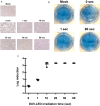Rapid inactivation of SARS-CoV-2 with deep-UV LED irradiation
- PMID: 32673522
- PMCID: PMC7473214
- DOI: 10.1080/22221751.2020.1796529
Rapid inactivation of SARS-CoV-2 with deep-UV LED irradiation
Abstract
The spread of novel coronavirus disease 2019 (COVID-19) infections worldwide has raised concerns about the prevention and control of SARS-CoV-2. Devices that rapidly inactivate viruses can reduce the chance of infection through aerosols and contact transmission. This in vitro study demonstrated that irradiation with a deep ultraviolet light-emitting diode (DUV-LED) of 280 ± 5 nm wavelength rapidly inactivates SARS-CoV-2 obtained from a COVID-19 patient. Development of devices equipped with DUV-LED is expected to prevent virus invasion through the air and after touching contaminated objects.
Keywords: COVID-19; SARS-CoV-2; antiviral efficacy; contact transmission; deep-UV LED; fomite infection; inactivation.
Conflict of interest statement
H.S. receives part of his salary from Nikkiso Co., Ltd., Tokyo, Japan. Nikkiso supplied the deep ultraviolet light-emitting diode (DUV-LED) instrument for evaluation. Nikkiso had no role in study design, data collection and analysis, decision to publish, or preparation of the manuscript. The other authors declare no conflicts of interest.
Figures

References
Publication types
MeSH terms
LinkOut - more resources
Full Text Sources
Other Literature Sources
Miscellaneous
